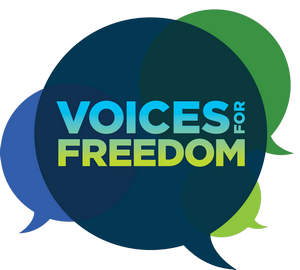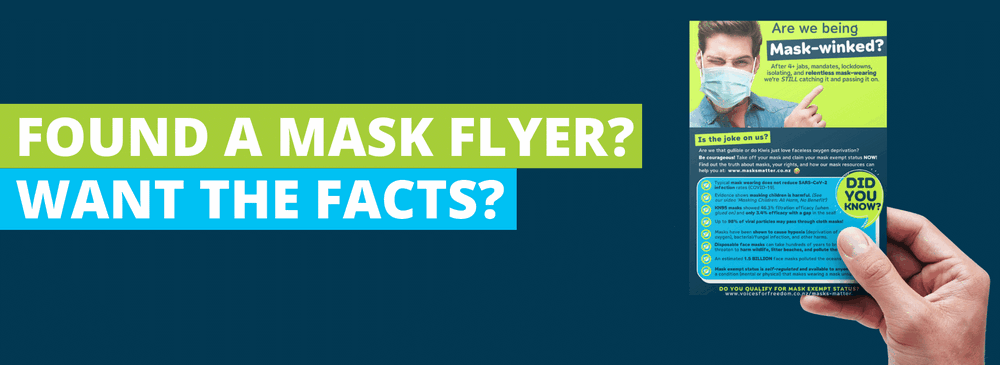
Welcome! So, you have a mask flyer in your hand and you’re looking for more info to back up the claims on the sheet? You’re in the right place!
Read on to find the references and share them with your friends. (We will be adding further to these facts as more information comes to light)…
Note: The Advertising Standards Authority Decision On Voices For Freedom’s Previous Mask Flyer:
“Were any of the statements in the leaflet misleading?
The Complaints Board agreed that none of the six statements made in the advertisement were misleading, because they had been adequately substantiated in the context of advocacy advertising.”
Read the decision here: https://www.asa.co.nz//backend/documents/2021/07/20/21318.pdf
Read Our 2021 Submissions in response to our Summer Mask Flyer.
Claim 1:
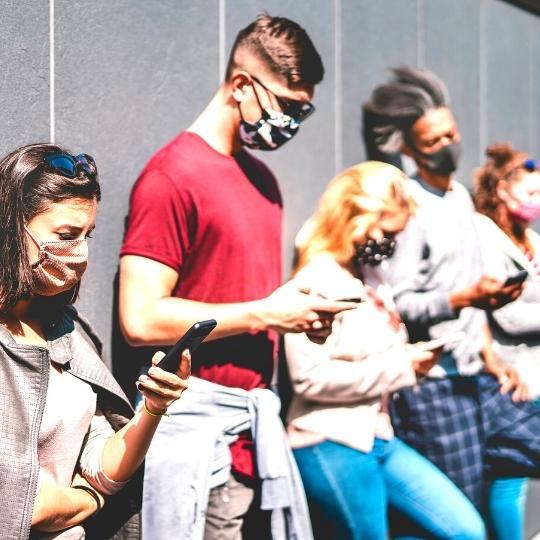
Typical mask wearing does not reduce SARS-CoV-2 infection rates (COVID-19).
A high-quality, large-scale Danish study published in November 2020 found NO evidence that wearing a face mask significantly minimised people’s risk of contracting COVID-19.
The randomised-control trial found no statistically significant difference in coronavirus infection rates between mask-wearers and non-mask-wearers. In fact, according to the data, mask usage may actually increase the likelihood of infection.
The mask study was one of the largest of its kind ever completed.
https://www.acpjournals.org/doi/10.7326/M20-6817
Claim 2:
Evidence shows masking children is harmful.
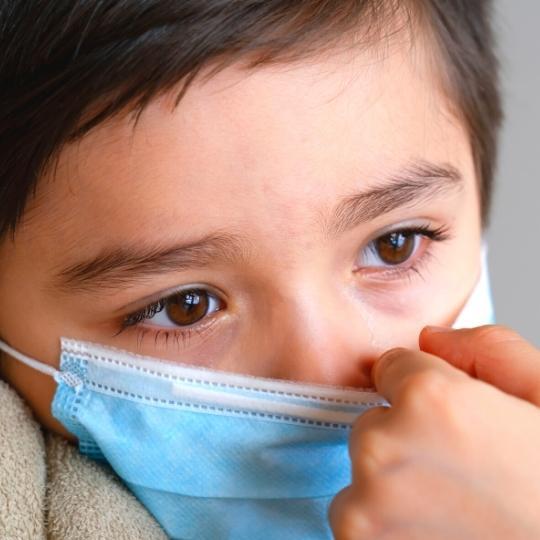
Children exposed to masked adults in the first year of life demonstrated lower expressive vocabulary:
“New challenges have arisen during the COVID-19 pandemic, and questions have been raised about how social isolation and mask-wearing have affected the language developmental trajectories of young infants. Facial expressions and gestures have played an important role in evolutionary history and have been associated with language acquisition. Humans rely on the way the mouth displays emotion. The extent to which the mouth is observed in proportion to the eyes may affect the child’s ability to communicate in a typical way. Covering the mouth also eliminates the lip-reading cues that enable infants to understand language,4 and slows down the neural processing of auditory speech signals. This has a detrimental effect on speech perception.
…infants exposed to shorter mask-wearing produced significantly more words than the longer mask group (mean 17.21 ± 18.3 vs. 7.5 ± 5.07, respectively, t= 2.867, p< 0.01). Children who were exposed to masked caregivers for a longer time produced a significantly lower number of words.”
https://pubmed.ncbi.nlm.nih.gov/35917226/
Jan 2022: Evidence Summary Coronavirus (COVID-19) and the use of face coverings in education settings:
“A survey conducted by the Department for Education in March 2021 found that…80% of pupils reported that wearing a face covering made it difficult to communicate, and more than half felt wearing one made learning more difficult (55%).
Watch our video ‘Masking Children: All Harm, No Benefit’
OFSTED Report, April 2022:
“The pandemic has continued to affect children’s communication and language development, and many providers noticed delays in their speech and language progress. Providers are making more referrals for external help than before the pandemic and are waiting longer for this specialist help.
… Children turning 2 years old will have been surrounded by adults wearing masks for their whole lives and have therefore been unable to see lip movements or mouth shapes as regularly. Some providers have reported that delays to children’s speech and language development have led to them not socialising with other children as readily as they would have expected previously.”
Study: Impact of the COVID-19 Pandemic on Early Child Cognitive Development: Initial Findings in a Longitudinal Observational Study of Child Health:
“While children, and those under age 5, have largely been spared from the severe health and mortality complications associated with SARS-CoV-2 infection [1, 2], they have not been immune to the impact of the stay-at-home, masking, and social distancing.
…In addition, masks worn in public settings and in school or daycare settings may impact a range of early developing skills, such as attachment, facial processing, and socio-emotional processing.
…One aspect also not investigated here is the impact of mask-wearing by the study staff during child visits and assessments [53]. The inability of infants to see full facial expressions may have eliminated non-verbal cues, muffled instructions, or otherwise altered the understanding of the test questions and instructions. ”
https://www.medrxiv.org/content/10.1101/2021.08.10.21261846v1.full.pdf
“While children, and those under age 5, have largely been spared from the severe health and mortality complications associated with SARS-CoV-2 infection [1, 2], they have not been immune to the impact of the stay-at-home, masking, and social distancing.
…In addition, masks worn in public settings and in school or daycare settings may impact a range of early developing skills, such as attachment, facial processing, and socio-emotional processing.
…One aspect also not investigated here is the impact of mask-wearing by the study staff during child visits and assessments [53]. The inability of infants to see full facial expressions may have eliminated non-verbal cues, muffled instructions, or otherwise altered the understanding of the test questions and instructions. ”
https://www.medrxiv.org/content/10.1101/2021.08.10.21261846v1.full.pdf
Claim 3:
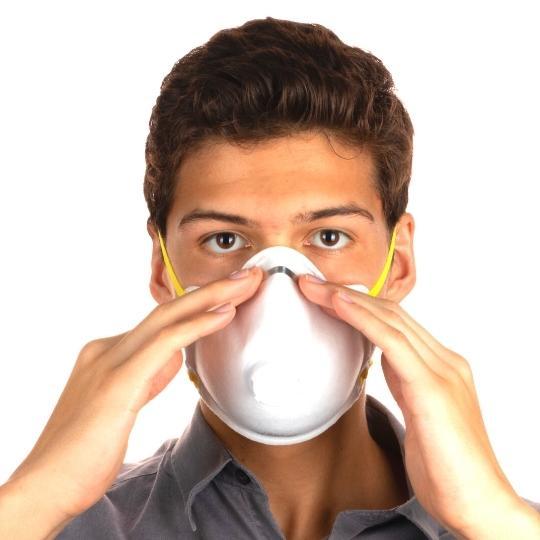
KN95 masks showed 46.3% filtration efficacy (when glued on) and only 3.4% efficacy with a gap in the seal!
“In order to further evaluate the effect of leakage through the gaps around the cheeks and the nose, a separate case with the KN95 mask was considered with 3 mm gaps created artificially, as described in Sec. II. The 3 mm gaps are representative of the typical gaps observed for the surgical and cloth masks and provide a “loose-fitting” KN95 case. Results for the KN95-gap case in Fig. 6 and Table III show a significant reduction in the filtration efficiency compared to the baseline KN95 mask, with ηAFE decreasing from 46.3% to a paltry 3.4%.”
Claim 4:
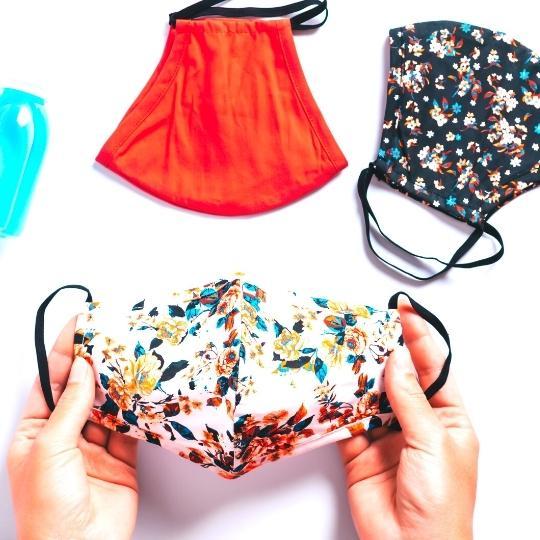
Up to 98% of viral particles may pass through cloth masks!
“The results showed that cloth masks and other fabric materials tested in the study had 40-90% instantaneous penetration levels against polydisperse NaCl aerosols employed in the National Institute for Occupational Safety and Health particulate respirator test protocol at 5.5 cm s⁻¹. Similarly, varying levels of penetrations (9-98%) were obtained for different size monodisperse NaCl aerosol particles in the 20-1000 nm range.
Results obtained in the study show that common fabric materials may provide marginal protection against nanoparticles including those in the size ranges of virus-containing particles in exhaled breath.“
https://academic.oup.com/annweh/article/54/7/789/202744
“..our results suggest that cloth masks are only marginally beneficial in protecting individuals from particles<2.5 μm.”
Claim 5:
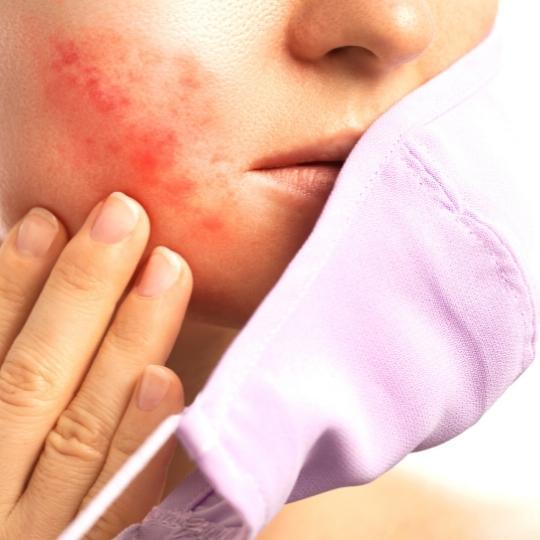
Masks have been shown to cause hypoxia (deprivation of adequate oxygen), bacterial/fungal infection, and other harms.
“Wearing an N95 mask for 4 hours during HD significantly reduced PaO2 (partial pressure of oxygen) and increased respiratory adverse effects in ESRD patients.”
https://pubmed.ncbi.nlm.nih.gov/15340662/
A 2015 study indicated that hypoxia inhibits T-lymphocytes (the main immune cells used to fight viral infections) by increasing the level of a compound called hypoxia inducible factor-1 (HIF-1).
https://pubmed.ncbi.nlm.nih.gov/26179900/
“Human beings must breathe oxygen . . . to survive, and begin to suffer adverse health effects when the oxygen level of their breathing air drops below [19.5 percent oxygen]. Below 19.5 percent oxygen . . . , air is considered oxygen-deficient. At concentrations of 16 to 19.5 percent, workers engaged in any form of exertion can rapidly become symptomatic as their tissues fail to obtain the oxygen necessary to function properly.”
https://www.osha.gov/laws-regs/standardinterpretations/2007-04-02-0
A study on 53 surgeons using a pulse oximeter pre and postoperatively:
“Considering our findings, pulse rates of the surgeon’s increase and SpO2 decrease after the first hour. This early change in SpO2 may be either due to the facial mask or the operational stress. Since a very small decrease in saturation at this level, reflects a large decrease in PaO2, our findings may have a clinical value for the health workers and the surgeons.”
Claim 6:
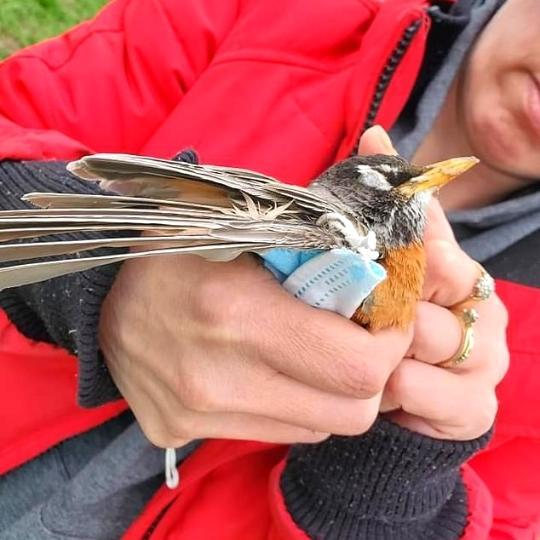
Masks have been shown to cause hypoxia (deprivation of adequate oxygen), bacterial/fungal infection, and other harms.
“A study using community science observations from around the world found that disposable face masks and plastic gloves could pose an ongoing risk to wildlife for tens if not hundreds of years. Entanglements were one of the most prevalent threats, with some animals being killed after becoming caught in the plastic debris.
…From March to October 2020, this caused the amount of abandoned face masks to increase by more than 80 times to represent almost 1% of all dumped litter globally, and as much as 5% in the UK.
… With disposable face masks estimated to take up to 450 years to decompose, the waste left behind by the response to COVID-19 will have to be considered in any future attempts to tackle global plastic pollution.”
Claim 7:
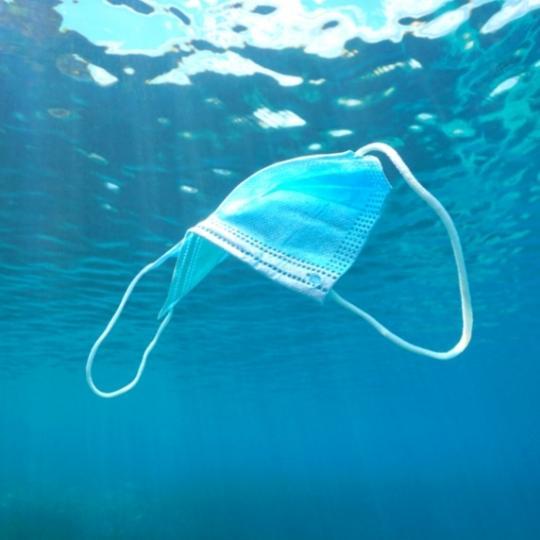
An estimated 1.5 BILLION face masks polluted the oceans last year!
More than 1.5 billion disposable face masks wound up in the world’s oceans last year — polluting the water with tons of plastic and endangering marine wildlife, according to a Hong Kong-based environmental group.
https://nypost.com/2020/12/28/more-than-1-5b-masks-will-pollute-oceans-this-year-report/
Claim 8:
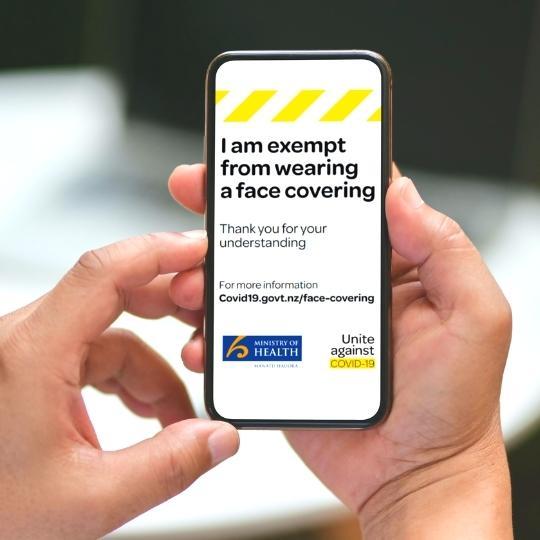
Mask exempt status is self-regulated and available to anyone who has a condition (mental or physical) that makes wearing a mask unsuitable.
View the Government’s legislation here:
www.legislation.govt.nz/regulation/public/2021/0386/latest/whole.html
Official NZ Government COVID-19 information on who does not need to wear a face mask:
Claim 9:
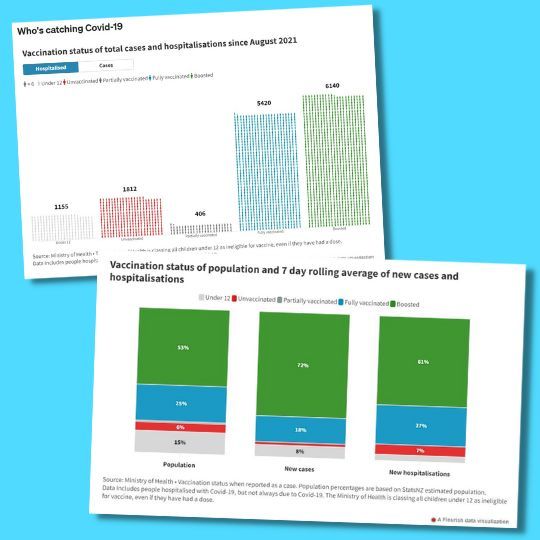
After 4+ jabs, mandates, lockdowns, isolating, and relentless mask-wearing we’re STILL catching it and passing it on.
Evidence of sustained, widespread infection of a large number of Kiwis, regardless of their vaccination status or other non-pharmaceutical intervention strategies, can be found on the Ministry of Health website HERE. As of 1 September 2022 there have been 1,743,042 reported cases of Covid-19 in New Zealand.
The Government’s own data showed that boosted individuals were over-represented in the official case and hospitalisation numbers. Read more about these charts over on the blog.
Official interactive COVID-19 data and charts can be found on this RNZ page.
